Regime switching models for circular and linear time series
Abstract
The score-driven approach to time series modelling is able to handle circular data and switching regimes with intra-regime dynamics. Furthermore it enables a dynamic model to be fitted to a linear and a circular variable when their joint distribution is a cylinder. The viability of the new method is illustrated by estimating models for hourly data on wind direction and speed in Galicia, north-west Spain. The modelling of intra-regime dynamics is shown to be of critical importance.
1 INTRODUCTION
Many areas of environmental statistics involve applications where circular data are collected and statistically analysed. For example, modelling and forecasting wind direction is relevant for tracking pollution and wildfires. Harvey et al. (2022) show how a score-driven approach1provides a solution to time series modelling of circular data. The present article extends this approach to handle data from time series where there is switching between different regimes and shows how dynamic bivariate models for speed and direction can be constructed.
The viability and effectiveness of the new methods is illustrated with data on wind direction and speed at a wind farm site in Galicia, North-West Spain. The observations were taken every minute over the month of January 2004. These data are used by García-Portugués et al. (2013) in a study of pollution. Figure 1 shows the time series of observations, measured in radians from 0 to obtained by taking the last observation in each hour. Zero radians corresponds to due east with the subsequent coding being anti-clockwise so is north, is west and is south. Because of circularity some of the measurements in the North East (NE) orbit appear at the top, close to rather than near the bottom. Serious distortions can arise if circularity is not taken into account and standard linear time series methods are used.
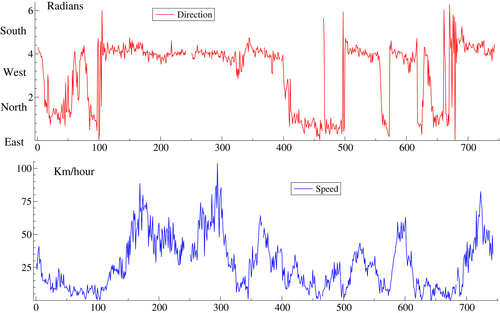
García-Portugués et al. (2013) note that the prevailing wind comes from two directions: SW and NE. The two dominant directions are apparent in Figure 1 with NE being a little less than one radian and SW around four. Hence a regime switching model may be appropriate. Holtzmann et al. (2006) propose a switching regime model for wind direction and the same approach is used by Zucchini et al. (2016, pp. 228–35), for modeling the change in direction of flight for fruit flies. The basic formulation assumes a finite number of regimes and introduces dynamics by a Markov chain in which there is a fixed probability of staying in the current regime or moving to another; see Hamilton (1989, 1994). The regime is not observed: hence the term hidden Markov model (HMM) as in Zucchini et al. (2016). The probability of being in a particular regime is given by a filter that depends on past observations. These probabilities yield a conditional mixture distribution for the current observation and hence a likelihood function. Catania (2021) proposes a different approach that by-passes the hidden Markov chain and instead sets up filters for the regime probabilities in the conditional distribution directly by using their scores. He calls these dynamic adaptive mixture models (DAMMs). The score-driven approach leads naturally to a solution of how to model intra-regime dynamics. The key point is that the forcing variables in dynamic equations are a function of past observations weighted according to the probability that they are in a given regime. Intra-day dynamics have not been modelled in this way in standard HMMs. Yet in many environmental applications there are marked intra-regime dynamics. The evidence presented here shows that neglecting these dynamics can be a major drawback.
Figure 1 also shows wind speed. Wind speed is a (non-negative) linear variable and a joint model distribution of a linear and a circular variable takes the form of a cylinder. Abe and Ley (2017) proposes a general distribution for cylindrical data. A key feature of their distribution is that the circular concentration is allowed to increase with the linear component, a phenomenon first identified in the seminal article by Fisher and Lee (1992, p. 666). The challenge is to move from the static to the dynamic case. We show here that a score-driven approach facilitates the construction of a model that allows the location of the circular variable and the level (scale) of the linear variable to change over time. The concentration may also change.
The bivariate score-driven model can be incorporated in a regime switching model. Switching bivariate models have been used by Lagona et al. (2015) for modeling the joint distribution of wave height and direction in the Adriatic; they employ an HMM for fitting a cylindrical distribution when there are three distinct regimes. Other applications involving speed and direction include tracking and forecasting the movements of animals, boats and wildfires, as in García-Portugués et al. (2014).
Section 2 reviews the score-driven model for circular data proposed by Harvey et al. (2022) and fits it to wind direction in Galicia. The theory underlying regime switching models is described in section 3 and it is shown how the score-driven approach set out in Section 2 is able to model dynamic location and concentration within regimes. The methods are applied to the Galicia data on wind direction in Section 4. Dynamic cylindrical distributions are described in Section 5 and extended to handle switching regimes. These time series models are fitted to the Galicia data on direction and speed in Section 6. Section 7 concludes.
2 SCORE-DRIVEN MODELS FOR CIRCULAR DATA
Circular time series models currently in use are almost all based on the autoregressive-moving average (ARMA) type models proposed in Fisher and Lee (1994) or are regime switching models; see Pewsey and García-Portugués (2021, section 10.1). Score-driven models offer considerable advantages and allow regime switching to be combined with intra-regime dynamics.
2.1 Dynamic Location
A defining property of a (continuous) circular distribution is that it satisfies the periodicity condition where is an integer and denotes parameters. Provided the derivatives of the log-density with respect to the elements of are continuous, they too are circular in that the periodicity condition is satisfied. Thus the path of is the same irrespective of whether is defined in terms of or The conditional distribution of in a model defined by (3), (4) and (2) is therefore the same as that of and so the likelihood function of the wrapped observations, the is the same as that of the unobserved variables, the .
Harvey et al. (2022) provide further details and derive the asymptotic distribution of the ML estimators of and in (4) for the stationary vM model.
2.2 Tests
The Lagrange multiplier, or score, test against serial correlation in location is based on the portmanteau or Box–Ljung statistic constructed from the autocorrelations of the scores; see Harvey (2013, section 2.5). For a vM distribution with , the scores under the null hypothesis of constant location are proportional to Hence the sample autocorrelations correspond to the circular autocorrelations (CACFs) in Jammalamadaka and SenGupta (2001, pp. 176–9).
2.3 Heteroscedasticity
2.4 Application to Circular Data from Galicia
When a basic first-order dynamic model, (4) is fitted to the Galicia data,2 the result is and The maximized log-likelihood is . The residual CACF shows there is considerable serial correlation remaining and the fit, as measured by dispersion (circular variance), is no better than that of a random walk in which see Mardia and Jupp (2000, pp. 18–19 and 30). Adding heteroscedasticity gives a better fit, but although this reduces the serial correlation in dispersion, the serial correlation in location increases.
3 SWITCHING REGIMES
The plot of wind direction in Galicia provides a clear motivation for a switching model. The first subsection below gives a short description of the static mixture model before moving on to review the dynamic adaptive mixture model (DAMM) of Catania (2021). The third subsection then shows how the score-driven approach can handle intra-regime dynamics and in the subsection following the associated diagnostic tests are set out. The last subsection discusses circular observations.
3.1 Static Mixture Model
The maximum likelihood (ML) estimates for the parameters in each of the together with the unconditional probabilities, can be computed iteratively by what turns out to be a special case of the EM algorithm; see Hamilton (1994, pp. 688–9), or Zucchini et al. (2016).
3.2 Dynamic Mixture Model
3.3 Dynamics Within Regimes
Remark 1.In the classic Markov switching model, dynamics are introduced into the location and/or scale of each regime by letting them depend directly on past observations. For example the conditional mean in the th regime is often given by see Hamilton (1994, p. 691). By contrast, the score-driven approach leads to a filters driven by a forcing variable that is weighted by the probability of being in the th regime. This defining feature of the score-driven model also distinguishes it from the treatment of switching conditional heteroscedasticity in the financial literature; see, for example, Haas et al. (2004) and the discussion in Catania (2021, sections 2 and 3).
3.4 Model Selection and Diagnostics
Following on from the work of Hamilton (1996), Smith (2008) finds LM tests to have the best size and power properties for Markov switching models. The structure of the DAMM is such that LM diagnostic tests are easily formulated. When a static mixture model has been fitted, evidence for serial correlation in the regime dynamics and the intra-regime dynamics is separated out. Formal tests against dynamics can be constructed and the pattern of serial correlation displayed in correlograms. As shown by the application in Section 4.1, this can be of great benefit for model specification. When dynamics have been estimated, diagnostics designed to assess the possibility of omitted dynamic effects can be formulated using the same principles.
Under the null hypothesis that the model is a static mixture with no dynamics, LM tests against dynamics in regime switching and in the parameters within each regime may be constructed. In a two state model, the test is against dynamic switching of the form where is as in (10). When the model is static , because, from (7), , where, as before, the subscript is dropped from Thus, following Harvey (2013, section 2.5), the LM test of the null hypothesis that the model is static, that is against for some is equivalent to a portmanteau -test based on the correlogram of the estimated probabilities, The critical values are taken from a distribution.
When dynamic models have been fitted to the regime probabilities, as in the basic DAMM, LM test statistics for location dynamics in individual regimes can be constructed. Similarly, when dynamics have been estimated within regimes, LM tests for omitted dynamics can be set up. Tests for heteroscedasticity can be similarly formed; see, for example, Calvori et al. (2017). However, if the effect of fitting dynamics to the and to location and/or scale, is ignored, simple tests may be used to give an indication of serial correlation in each regime. Harvey and Thiele (2016) show that this can often be a good strategy and it is the one we adopt here.
3.5 Circular Mixture Models
A portmanteau test, (16), against dynamics in the level of the th regime is based on the (circular) correlogram of the residuals . Note that although the score is , the concentration parameter, cancels out.
4 SWITCHING MODELS FOR GALICIA
Tables I and II show ML estimates for switching models applied to the Galicia data. The numerical maximization was carried out in Matlab using an interior-point method that follows a barrier approach to solve the subproblems occurring in each Newton–Raphson iteration; see, for example, Waltz et al. (2006). Estimates of the asymptotic standard errors, obtained from the numerical Hessian, are shown in brackets. The parameter is the logarithm of the concentration, When heteroscedastic models are fitted, it is in (6).
| Model | AIC | BIC | Logl | ||||
|---|---|---|---|---|---|---|---|
| (1) | 1,643.580 | 1,666.640 | 0.680 | – | – | 0.664 | |
| (0.087) | |||||||
| (2) | 980.255 | 1,012.539 | 2.194 | 0.959 | 4.766 | 0.900 | |
| (0.808) | (0.012) | (0.631) | |||||
| (3) | 490.554 | 541.286 | 1.192 | 0.959 | 5.774 | 0.767 | |
| (0.838) | (0.013) | (0.690) | |||||
| (4) | 459.400 | 528.581 | 1.724 | 0.944 | 5.360 | 0.849 | |
| (0.840) | (0.021) | (0.895) |
- Note: The switching parameters are shown in the last four columns, with denoting the logistic transformation of .
| Model | ||||||||||||
|---|---|---|---|---|---|---|---|---|---|---|---|---|
| (1) | 4.051 | – | – | 2.540 | – | – | 1.055 | – | – | 0.735 | – | – |
| (0.014) | (0.101) | (0.056) | (0.130) | |||||||||
| (2) | 4.041 | – | – | 2.437 | – | – | 1.032 | – | – | 0.848 | – | – |
| (0.014) | (0.066) | (0.049) | (0.090) | |||||||||
| (3) | 4.136 | 0.914 | 0.013 | 3.318 | – | – | 3.165 | 0.989 | 0.257 | 1.243 | – | – |
| (0.040) | (0.026) | (0.002) | (0.067) | (0.403) | (0.005) | (0.026) | (0.073) | |||||
| (4) | 4.107 | 0.917 | 0.015 | 3.060 | 0.856 | 0.255 | 2.305 | 0.983 | 0.173 | 1.426 | 0.309 | 0.774 |
| (0.038) | (0.023) | (0.002) | (0.104) | (0.069) | (0.068) | (0.156) | (0.004) | (0.023) | (0.125) | (0.068) | (0.143) |
Diagnostic test statistics for assessing residual serial correlation in different components are in Table III. We originally calculated -statistics for and 20 but the message in all three is essentially the same, so only is given here. When dynamics are fitted, the tests should not be treated formally because, as indicated earlier, the distribution is no longer under the null hypothesis. Furthermore, because the sample size is large, with -statistics based on relatively small sample autocorrelations can still be big. Their main value is to convey a strong message about which models are most effective.
| Model | |||||
|---|---|---|---|---|---|
| (1) | |||||
| (2) | |||||
| (3) | 4.176 | ||||
| (4) | 7.776 |
- Note: (Nominal) significance levels: 0.01 ‘***’, 0.05 ‘**’, 0.1 ‘*’.
4.1 Static Mixture
Although the static mixture model can be ruled out from the correlogram of the raw data, it is nevertheless informative about the regimes. Numerically optimizing the log-likelihood function gave the values in the first row of Table II, that is and note that The log-likelihood, in Table I, is which is far lower than we obtained for the single regime dynamic model reported in Section 2.4, and the -statistics are huge.
The plot of in Figure 2 shows how the contrast between the distributions in the two regimes gives a clear indication of which regime is operative at any one time. The regimes are obviously not determined randomly and the ACF of the indicates that a fairly persistent first-order filter, as in (11), is likely to give a good fit. The circular ACFs (CACFs) for the individual regimes in the lower panels indicate persistent dynamics in the location. The correlations between the three scores are not far from zero.
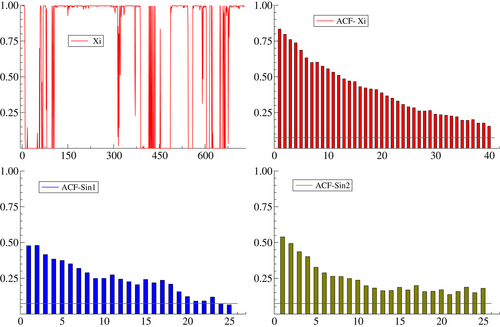
4.2 Dynamic Mixtures
Although the tests indicate dynamics within each regime, it is useful to begin by fitting a pure DAMM, that is one without intra-regime dynamics but with a dynamic equation for as in (11). The estimates of and are similar to the estimates found for the static mixture model except that the estimate of is, at 0.90, somewhat higher than the static estimate of 0.66. The log-likelihood is so there is a clear improvement over the static mixture model.
The diagnostic test based on the switching residuals, shown in the column headed in Table III, indicates that most of the dynamic movements have been captured by the regime-switching equation. However, the -statistics for location dynamics remain very high in both regimes; indeed the correlograms are not dissimilar to those in Figure 2. Both are consistent with a first-order dynamic model, (14), for each regime.
Fitting an HMM gives a result very close to that of the DAMM. The log-likelihood is slightly lower, at , but the AIC and BIC are slightly bit smaller, reflecting the fact that the HMM has one fewer parameter. The finding that the pure switching model is inadequate is important because most, if not all, of the research in this area has been restricted to pure Markov switching models. Indeed only three pages are devoted to intra-regime dynamics in the book by Zucchini et al. (2016, pp. 150–2).
4.3 Dynamic Mixture Model with Intra-regime Dynamics
The diagnostics show that serial correlation in location has been eliminated. However, the scores for concentration indicate dynamics. When, in the last line, the model is extended to allow for heteroscedasticity, there is a further improvement in goodness of fit and the level in regime 2 falls to 2.31. On the other hand the underlying probability of being in regime 1, that is rises from 0.767 to 0.849.
Finally the likelihoods for the two switching models with intra-regime dynamics are, as expected, much bigger than those of the corresponding single regime models and, despite the extra parameters, the AICs and BICs are much smaller.
5 MODELING THE CYLINDER
A bivariate distribution for a circular and a linear variable takes the form of a cylinder. This section shows how a dynamic model can be constructed. The last subsection makes the extension to a bivariate regime switching model.
5.1 Weibull–von Mises (Abe-Ley) Distribution
5.2 Dynamic Model
Both and retain the univariate circularity property of being unchanged when multiples of are added or subtracted from The circularity of the scores confirms that when a dynamic score-driven model for a WeiVM distribution, , allows to range over the whole real line, it may be wrapped, as in (2), to give a likelihood function, based on (18), that is the same as that of the (infeasible) likelihood function for .
5.3 Heteroscedasticity
The heteroscedastic dynamic model includes an equation for to complement those in (21). The information matrix for and is given in the Supporting information. Its availability raises the possibility of pre-multiplying the scores by its inverse, as is often done in the dynamic score literature.
Remark 2.Abe and Ley (2017, pp. 96–7), p 96-7, give a generalization,4 the GGSSVM, in which the generalized gamma (GG) distribution replaces the Weibull; the circular marginal distribution is then the Jones-Pewsey distribution. Imoto et al. (2019) propose a generalized Pareto-type cylindrical distribution that can handle heavier tails. In both cases a score driven model can again be formulated.
5.4 Forecasts
5.5 Switching Cylinders
The graphs in Figure 1 suggest that the regimes for direction are more clearly defined than those for speed. Thus it is worth considering whether to model regime switching only in terms of the marginal distribution of direction, . To implement such a regime switching mechanism, the PDF in the score with respect to the dynamic switching probability, that is (11), is taken to be wrapped Cauchy, as in (25), and the same density is used in the contemporaneous probability (13).
6 WIND DIRECTION AND SPEED IN GALICIA
The scatter plot of speed and direction for the Galicia data in Figure 3 highlights the regimes in direction and confirms the impression gained from Figure 1 that speed tends to be higher when the wind is coming from the SW.
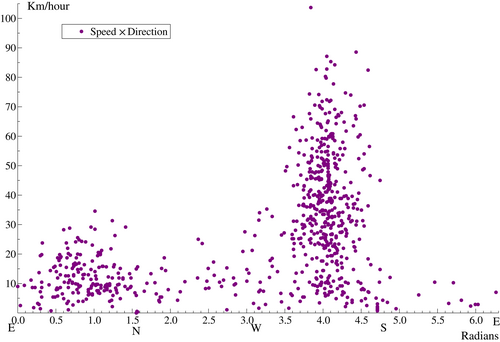
As might be expected from the univariate results on wind direction, a static mixture model fares badly, with as opposed to for the single regime model without heteroscedasticity and with heteroscedasticity. The pure DAMM model, shown in the second line of Table IV and labelled model (6), is much better, with but it too fails to beat the single regime models. The score-based -statistics for residual serial correlation shown in Table VI are huge.
| Model | AIC | BIC | Logl | ||||
|---|---|---|---|---|---|---|---|
| (5) | 7,482.446 | 7,523.954 | 0.994 | – | – | 0.730 | |
| (0.097) | |||||||
| (6) | 6,849.460 | 6,900.193 | 1.084 | 0.846 | 11.079 | 0.747 | |
| (0.552) | (0.022) | (1.224) | |||||
| (7) | 6,034.761 | 6,122.389 | 1.151 | 0.924 | 7.729 | 0.760 | |
| (0.664) | (0.015) | (1.114) | |||||
| (8) | 5,992.685 | 6,098.762 | 1.669 | 0.870 | 27.487 | 0.842 | |
| (0.561) | (0.020) | (0.833) | |||||
| (9) | 6,018.408 | 6,106.037 | 1.336 | 0.966 | 5.594 | 0.792 | |
| (0.828) | (0.010) | (1.076) | |||||
| (10) | 5,939.650 | 6,045.727 | 0.032 | 0.879 | 15.945 | 0.508 | |
| (0.552) | (0.016) | (2.524) |
- Note: Models (9) and (10) are specified in the same way as (7) and (8) except that the switching probability is driven by the marginal distribution with respect to location. The switching parameters are shown in the last four columns, with denoting the logistic transformation of .
The inclusion of dynamics within regimes offers considerable improvement. As before the fit is better with heteroscedasticity dynamics. The main issue to resolve is whether the dynamics in the switching equation should depend on both direction and speed or on direction only. The results favour the second possibility, especially when the dynamics include heteroscedasticity. Thus the estimates reported in the last lines of Tables IV–VI are for the preferred model. As can be seen, . There is still some residual serial correlation in some of the components, but, as noted earlier, this is not unusual with large sample sizes. The estimates of in the Weibull parameter are well above one in almost all cases.
| Model | ||||||||||||||||||||
|---|---|---|---|---|---|---|---|---|---|---|---|---|---|---|---|---|---|---|---|---|
| (5) | 4.046 | – | – | 2.418 | – | – | 0.695 | – | – | 2.115 | 0.886 | – | – | 1.561 | – | – | 0.543 | – | – | 2.021 |
| (0.012) | (0.054) | (0.024) | (0.033) | (0.028) | (0.096) | (0.051) | (0.057) | |||||||||||||
| (6) | 4.048 | – | – | 2.422 | – | – | 0.735 | – | – | 2.171 | 0.917 | – | – | 1.732 | – | – | 0.381 | – | – | 2.002 |
| (0.011) | (0.045) | (0.022) | (0.029) | (0.032) | (0.025) | (0.047) | (0.041) | |||||||||||||
| (7) | 4.002 | 0.927 | 0.010 | 2.218 | 0.978 | 0.021 | 0.748 | – | – | 3.575 | 1.694 | 0.992 | 0.043 | 1.622 | 0.811 | 0.089 | 0.489 | – | – | 2.329 |
| (0.032) | (0.025) | (0.002) | (0.080) | (0.005) | (0.002) | (0.021) | (0.029) | (0.110) | (0.003) | (0.007) | (0.016) | (0.047) | (0.010) | (0.041) | (0.031) | |||||
| (8) | 4.048 | 0.941 | 0.008 | 2.161 | 0.976 | 0.023 | 0.592 | 0.912 | 0.015 | 3.398 | 0.854 | 0.982 | 0.013 | 1.798 | 0.802 | 0.046 | 1.261 | 0.998 | 0.067 | 2.342 |
| (0.001) | (0.024) | (0.001) | (0.124) | (0.000) | (0.002) | (0.027) | (0.027) | (0.003) | (0.054) | (0.071) | (0.019) | (0.004) | (0.002) | (0.068) | (0.006) | (0.133) | (0.000) | (0.014) | (0.033) | |
| (9) | 3.998 | 0.919 | 0.010 | 2.274 | 0.972 | 0.027 | 0.744 | – | – | 3.478 | 1.408 | 0.967 | 0.052 | 1.482 | 0.924 | 0.051 | 0.485 | – | – | 2.481 |
| (0.030) | (0.025) | (0.002) | (0.110) | (0.007) | (0.003) | (0.020) | (0.031) | (0.082) | (0.013) | (0.011) | (0.166) | (0.038) | (0.010) | (0.053) | (0.047) | |||||
| (10) | 4.068 | 0.957 | 0.007 | 2.326 | 0.972 | 0.018 | –0.447 | 0.941 | 0.025 | 3.237 | 1.786 | 0.993 | 0.039 | 1.401 | 0.943 | 0.038 | –0.479 | 0.756 | 0.021 | 2.559 |
| (0.042) | (0.016) | (0.001) | (0.091) | (0.008) | (0.002) | (0.061) | (0.015) | (0.005) | (0.033) | (0.200) | (0.004) | (0.007) | (0.170) | (0.023) | (0.006) | (0.053) | (0.103) | (0.010) | (0.048) |
- Note: Models (9) and (10) are specified in the same way as (7) and (8) except that the switching probability is driven by the marginal distribution with respect to location.
| Model | |||||||
|---|---|---|---|---|---|---|---|
| (5) | |||||||
| (6) | |||||||
| (7) | 5.093 | 3.303 | |||||
| (8) | 3.479 | 3.737 | 6.806 | 1.069 | |||
| (9) | 3.459 | 1.528 | |||||
| (10) | 2.551 | 5.073 |
- Note: Models (9) and (10) are specified in the same way as (7) and (8) except that the switching probability is driven by the marginal distribution with respect to location. (Nominal) significance levels: 0.01 ‘***’, 0.05 ‘**’, 0.1 ‘*’.
The observations and combined filters for direction are shown in Figure 4. The filtered estimates are smoother than the raw observations. The filtered estimates stay well within the range whereas the observations sometimes move rapidly between the top and bottom of the graph. Note that the combined filter for mean direction is computed using the function, as in (17), while the corresponding filter for scale is
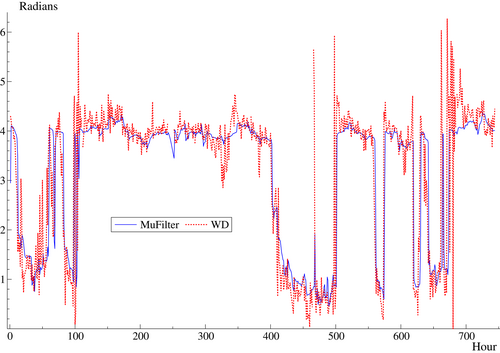
Figures 5 and 6 show filtered wind direction and speed in individual regimes. It can be seen that when the probability of being in a given regime is small, the movements in the underlying filter change only gradually. For wind direction, the combined filter of Figure 4 is also shown. The combined filter for speed is not shown as it is just the sum of the individual filters.
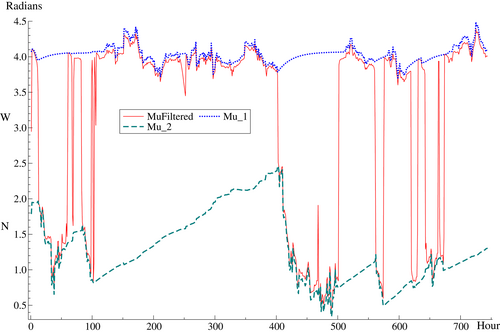

Remark 3.When there is no wind, it has no direction. In such cases and so the model gives which implies the (unobserved) wind direction is distributed uniformly. It is evident from (20) that the score for location, is zero. Thus the observation is effectively ignored as in the naive solution for dealing with an observation that is missing.5 This is not the case for the scale of the linear variable because and the concentration score where As regards the likelihood, the difficulty is that for indicating that is impossible. For which is also unhelpful. Only for is there a viable solution as in this case The simplest solution is to assume there is no contribution to the likelihood.
7 CONCLUSION
Score-driven regime switching models can be extended to handle circular observations and diagnostic tests can be constructed. The models allow for changing concentration as well as changing location. When fitted to hourly wind direction in a site in Galicia, pure regime switching models, without intra-regime dynamics, are unable to outperform the single regime model when both location and scale are dynamic. Although the diagnostic test based on the switching residuals indicates that there are no omitted dynamics in the regime-switching equation, the -statistics for location dynamics are still highly significant in both regimes. Fitting a score-driven switching model with location dynamics in each regime gives a big increase in the likelihood function.
The score-driven approach is then used to construct dynamic bivariate models for circular and linear variables with a conditional cylindrical distribution. The preferred specification for the Galicia data has dynamic location and concentration for wind direction and dynamic location/scale for its speed. Estimating a restricted regime switching model, in which the regime dynamics depend only on direction, gives a good fit when heteroscedasticity is included and the resulting filter for direction tracks the observations remarkably well. Again the modelling of intra-regime dynamics is crucial.
There is further scope for research extending the score-driven approach to bivariate dynamic cylindrical models based on copulas, as used by García-Portugués et al. (2013) and Lagona (2019), and to directional data on a sphere or torus.
ACKNOWLEDGEMENTS
We are grateful to Eduardo García-Portugués for providing the Galicia data used in García-Portugués et al. (2013). Earlier versions of some of the ideas in this article were presented at the Econometric Models of Climate Change conference in Milan in August 2019, at the 22nd Oxmetrics conference at Nuffield college, Oxford in September, 2019, and at workshops in Cambridge, Bologna, Ecole Polytechnique Féd érale de Lausanne, the QUT Centre for Data Sciences and the University of Konstanz. Later versions were given at a plenary (virtual) session of the 45th NBER-NSF conference in October 2021 at Rice University, Houston and at the ADISTA22 (Advances in Directional Statistics) conference in Santiago de Compostela in June 2022. We are grateful to Anthony Davison, Jurgen Doornik, David Hendry, Stan Hurn, Peter Jupp, John Kent, Francisco Lagona, Rutger-Jan Lange, Christophe Ley, Ken Lindsay, Oliver Linton, Alessandra Luati, Paul Myer, Alexiy Onatski, Richard Smith, Howell Tong and two referees for helpful comments.
Open Research
DATA AVAILABILITY STATEMENT
The data that support the findings of this study are available from the corresponding author on reasonable request.
References
- 1 Score-driven time series models were developed by Harvey (2013) and Creal et al. (2013), where they were called DCS and GAS models respectively.
- 2 The fact that the range of the observations is rather than makes no substantive difference to the results.
- 3 Abe and Ley (2017) have and
- 4 Note that they have replacing our and replacing
- 5 There is a run of missing observations on both wind and velocity around observation 250. In such cases we set all scores to zero: hence the slight dip in Figures 5 and 6. There are a few more missing observations around 455 and 680.




